How to Make Sun Dried Tomatoes
This post may contain affiliate links. See my disclosure policy.
Drying tomatoes is as easy as 1, 2, 3! Plus they’re cheaper than store-bought and taste WAY better! We’ll show you how to dry tomatoes in the sun, how to dry tomatoes in the oven, how to dry tomatoes in the dehydrator and how to store dried tomatoes. AND we’ll give you a list of ideas for delicious recipes using your sun dried tomatoes!
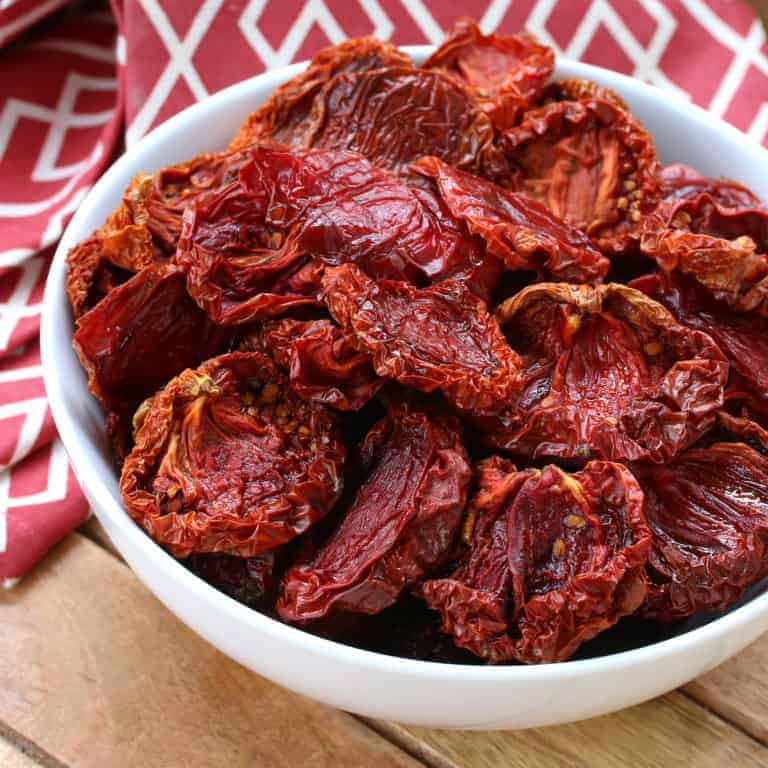
How to Make Sun Dried Tomatoes (in the Sun, Oven or Dehydrator)
We grow our own tomatoes every year and enjoy eating them fresh in salads, diced up for homemade canned tomatoes, transformed into my famous marinara sauce and homemade ketchup, spiced up in my restaurant-style salsa, made smooth and creamy in my creamy tomato soup, fried up in my fried green tomatoes, baked into roasted tomato bread, and any other way we can think to use them. Another one of my favorite ways to use our tomatoes, especially when I’ve got a large end-of-season bumper crop, is to dry them. While I don’t often “sun dry” them, the tomatoes are sun-ripened on the vine and once they’re dried in the oven or the dehydrator, these “sun dried” tomatoes taste so incredible you’d never even know the difference!
Still, we’ll tell you how to both sun dry and oven/dehydrator tomatoes so you can choose whichever method you prefer. We’ll also give you some tips for bumping up the flavor notes along with a list of delicious ideas for how to use your sun-dried tomatoes in cooking!
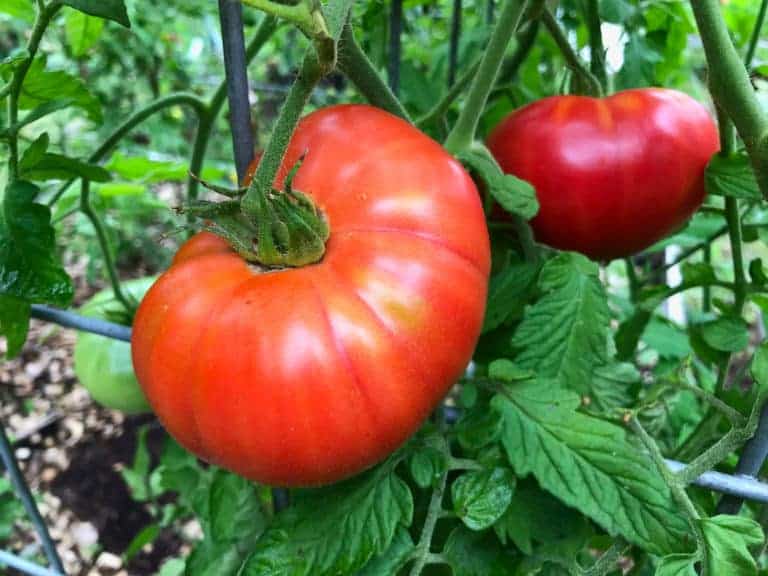
What Are Sun-Dried Tomatoes?
Sun-dried tomatoes, or whichever way you choose to dry them, are tomatoes that have generally lost 82-90+% of their original weight through the process of drying. They lose most of their water but retain their sugar, sweetness, and nutrients and what you’re left with is the deliciously dried tomato flesh with an absolutely incredible and intense, concentrated tomato flavor. They’re perfect for using in dishes where you really want that wonderful tomato flavor to shine through.
These sun-dried tomatoes can be used in a large variety of dishes (see suggestions further below) and can also be plumped up by storing them in olive oil, which opens up additional ways you can use them in cooking.
Three Ways to Dry Tomatoes: In the Sun, Oven or Dehydrator
Drying tomatoes in the sun is something people have been doing it for centuries. Simply cut the tomatoes in half, place them on a raised screen on some blocks (for circulation), sprinkle lightly with sea salt and place them directly in the hot sun to dry. But sun-drying tomatoes does come with its challenges. For one you do have less control over this method of drying because, well, Mother Nature is in charge. It requires both consistent warm temperatures and dry air. If you live in an area that’s humid, humidity makes drying tomatoes difficult if not impossible. Tomatoes also need to be brought inside or to a sheltered area overnight. Another challenge is that when you’re drying food outside you’re attracting more than the rays of sunshine…you’re opening your precious goods up to a critter picnic. To help circumvent that you can lay some cheesecloth over your tomatoes.
Bottom line: Use the sun-drying method is best reserved for those living in warmer, dryer areas with consistent, predictable weather. Depending on how hot it is it can also take a while, anywhere from a few days to a couple of weeks.

Drying tomatoes in the oven allows you to bypass all of the challenges associated with sun-drying. It gives you full control and delivers consistent results and in far less time – just a matter of just hours. You control the “weather” (aka, the oven temperature), you can set the time to go on or off whenever you need, and your tomatoes are in an enclosed space where flies and other critters can’t bother them.
Drying tomatoes in the dehydrator has the same advantages as using the oven. The only potential downside of a dehydrator is the noise (and that’s only if it bothers you), but the advantage is that it frees up your oven to use for other things. The other advantage is that you’re not having to use your oven in the heat of the summer.
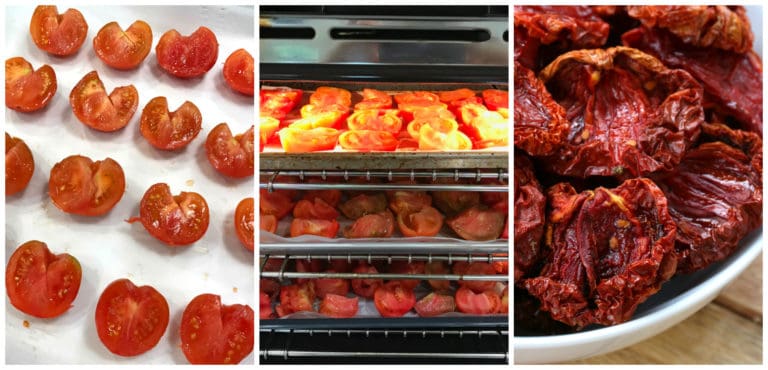
Which Kind of Tomatoes Should I Use? What Size Should I Use?
There is really no “should” about it, use whatever tomatoes you have access to. Generally fleshier varieties are recommended because they have less water to use and result in plumper dried tomatoes. But you can use any tomatoes you like, big or small. I use everything from cherry tomatoes to jumbo-sized tomatoes. Smaller tomatoes will dry more quickly, larger tomatoes will take longer.
The main thing to remember is to use uniformly sized tomatoes within the same batch so that they dry more or less at the same rate. Other than that, you can use any variety of tomato and any size of tomato you like.
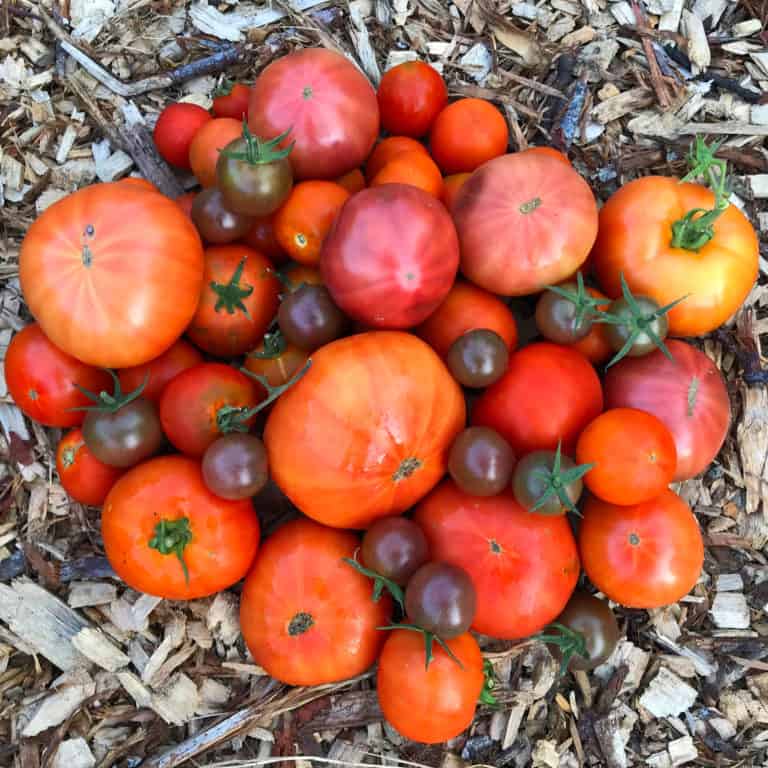
How Do I Add Some Additional Flavor to My Sun-Dried Tomatoes?
Along with the sea salt you can also sprinkle your tomatoes with any dried herbs or dried spices of your choice and then proceed with drying them as normal.
A Note on Salt
Be sure to go easy on the salt, use only a very light sprinkle. Remember that the tomatoes can lose 90+% of their original weight which means the salt will likewise become concentrated in what’s left of the tomato.
How Do I Know When My Tomatoes Are Done?
Your tomatoes are done when they are very dry but still pliable. When you squeeze them between your fingers they should be pliable/bendable (not brittle and snap), but they should not be remotely “squishy” or moist. Check your tomatoes regularly towards the end of the drying period: If the tomatoes are dried too long they’ll become tough and leathery. However if they’re not dried long enough they will become moldy very quickly.
How Do I Store Sun-Dried Tomatoes?
Place the fully-cooled dried tomatoes in an airtight bag or container and store them in the refrigerator where they will keep for a few months (depending on how much moisture is left in the tomatoes) or in the freezer where they will keep even longer. If storing them in the fridge do not keep them in the crisper drawer, they need to be kept dry, in as moisture-free of an environment as possible. Check the tomatoes frequently for any signs of mold and discard the tomatoes if you see any.
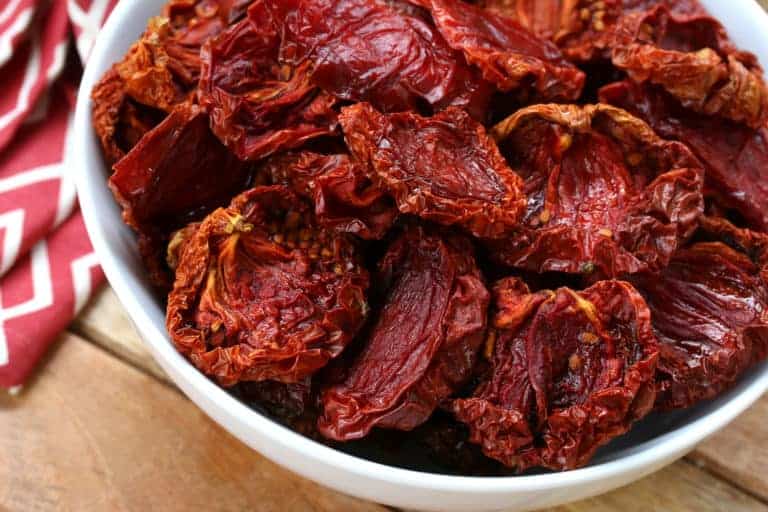
How Do I Reconstitute Sun-Dried Tomatoes?
To reconstitute dried tomatoes simply soak them in warm water for about 30 minutes or until soft and pliable. Remove them from the water, pat them dry with paper towels and use them as your recipe directs. And if you’re making soup or stew be sure to save and use that tomato soaking water! Alternatively, you can also soak the dried tomatoes in wine or broth.
How to Pack Sun-Dried Tomatoes in Olive Oil
Once your tomatoes are fully dried and cooled, you can pack them in olive oil if you like. This will plump them up and make them perfect for adding to things like antipasto and cheese/charcuterie platters, salad dressings, pasta salads, and anything else you’d normally use dried tomatoes in. Since they’re packed in olive oil they won’t need to be reconstituted with water and you have the option of adding more flavor to them by placing things like herbs and/or garlic in the olive oil along with the tomatoes. Here’s how to do it:
- Use small glass jars; the less air exposure the better. Avoid using metal jars or cans as they can create a metallic flavor. Select jars with tight-fitting lids.
- Reconstitute the dried tomatoes in warm water for about 30 minutes, lay them out and pat then with paper towels to remove as much moisture as possible.
- To further soften the tomatoes and to take that extra step of preventing bacterial growth, you can dip the tomatoes in wine vinegar, bottled lemon or lime juice before adding them to the olive oil.
- Pack the tomatoes in the jar, layering them with dried herbs and/or garlic as desired, then pour the olive oil over the top so the tomatoes are completely submerged in olive oil. Seal the jars tightly.
- The flavors improve over time. Let the tomatoes sit for at least a few days before using them, preferably longer. If using fresh herbs and garlic wait at least 24 hours before using.
- Note: If using fresh herbs and garlic be sure to store the jars in the fridge. Safety guidelines recommend using up the jars within 4 days (see more on that in the next section below). The oil in the jars stored in the fridge will solidify but will liquify quickly once at room temperature.
- If using dried herbs the oil-packed tomatoes can be stored at room temperature. You’ll know they’re bad if they taste rancid. If you discover any mold, discard immediately. However, we recommend storing the jars in the refrigerator for two reasons: It will reduce the risk of spoilage and it will extend their shelf life (generally up to 3 months), preventing the contents from becoming rancid as quickly. Again, the oil will solidify but will quickly liquify again at room temperature.
You can pack the tomatoes in oil as is or you can chop them up first for convenience for later adding them to salad dressings, in sauces, or however you want to use them.

Is It Safe to Pack Sun Dried Tomatoes In Oil?
According to the Oregon State Extension Service:
“Because of their acidity, unseasoned (i.e., no vegetables or herbs) fully dried tomatoes may be safely stored in oil at room temperature. (Refrigeration may delay rancidity, however). The tomatoes will soften more if quickly dipped in bottled lemon or lime juice before being placed in the oil. The tomatoes can be flavored with dried herbs and garlic. NOTE: Dried tomatoes-in-oil mixtures with [fresh] garlic and/or herbs MUST be refrigerated and used within 4 days or frozen for long-term storage.”
Note the words we italicized in bold: The tomatoes must be fully dried and only dried herbs and dried garlic can be used, otherwise the tomatoes in oil need to be stored in the fridge and used within 4 days or frozen. Nevertheless, to play it extra safe we recommend storing the jars in the fridge.
How To Use Sun-Dried Recipes in Cooking
The possibilities are endless! Here are a few ideas to get you started. Use sun-dried tomatoes in or on:
- Pasta Salads
- Sauces, Salad Dressings, Marinades, and Dips
- Compound Butter
- Soups and Stews
- Sandwiches and Pizzas
- Burgers
- Antipasto/cheese/charcuterie platters
- Meatballs
- Risotto
- Sun-Dried Tomato Pesto and Tapenade
- Frittata
- Added to Tomato Bread or Focaccia
- Mashed Potatoes
- Scrambled Eggs
- Caprese Salad (in addition to fresh tomatoes)

Looking for more ways to use up those fresh tomatoes?
Save This Recipe

How to Make Sun Dried Tomatoes (in the Sun, Oven or Dehydrator)
Ingredients
- 3 pounds ripe tomatoes (quantity is just a guideline, use more or less as desired) , washed and cut in half if medium-sized and quartered if large. Cut out the little core/stem parts. Note: Try to keep the sizes uniform so they dry more or less at the same rate.
- sea salt
- dried herbs/spices (optional)
- olive oil for packing (optional, see blog post above for instructions)
Instructions
- **For sun-drying and/or packing the tomatoes in olive oil, see blog post for instructions**Preheat the oven to 160 degrees F (a little higher is fine if your oven doesn't go that low). If using a dehydrator set the temperature between 140 and 160 degrees F. On a rack or parchment-lined baking sheet (do not use foil, it can react), arrange the tomatoes cut side up and sprinkle very lightly with sea salt. If desired, add some dried herbs or spices.Turn the tomatoes over around the halfway point so they can continue drying on the other side. For larger tomatoes press down on them gently with a spatula to flatten a little and release some of the liquid.NOTE: Even if your tomatoes are of uniform size they will still dry at somewhat different rates so keep an eye on them and remove the ones that are done while leaving the others to continue drying.If you have an extra large load of tomatoes in your oven, you can crack the oven door open an inch or two to allow for better circulation and prevent them from steaming. NOTE: Drying the tomatoes will take several hours, how many will depend on the size and water content of your tomatoes. The tomatoes are done when they are very dry but still pliable. If dried too long they will be tough and leathery or brittle, if not dried long enough they will become moldy quickly. When you press them between your fingers they should be pliable but not remotely squishy or moist. Makes roughly 2 1/4 cups dried tomatoes depending on the water content of the tomatoes and how long they were dried.
- To store: Place the fully-cooled dried tomatoes in an airtight bag or container and store them in the refrigerator where they will keep for a few months (depending on how much moisture is left in the tomatoes) or in the freezer where they will keep even longer. If storing them in the fridge do not keep them in the crisper drawer, they need to be kept dry, in as moisture-free of an environment as possible. Check the tomatoes frequently for any signs of mold and discard the tomatoes if you see any.
- How to Reconstitute Dried Tomatoes: Soak them in warm water for about 30 minutes or until soft and pliable. Remove them from the water, pat them dry with paper towels and use them as your recipe directs. And if you're making soup or stew be sure to save and use that tomato soaking water! Alternatively, you can also soak the dried tomatoes in wine or broth.To Pack the Dried Tomatoes in Olive Oil: *See blog post above for instructions.
Nutrition



















I’m wanting to make tomato/basil hummus with the tomatoes we have from a friend garden. I’ve never tried cooking with my own dried tomatoes before so this may seem like a silly question. I don’t see anything about using the dried tomatoes in recipes without reconstituting them. Do they have to be reconstituted to use in cooking?
Hi Jessica, yes, in most cases they’ll need to be reconstituted first by just letting them soak in water for 20-30 minutes. If you’re adding them to soups and stews you can add them as they are because they’ll soften as they simmer.
I freeze them after i dry them. They can last forever like this.
I do the same thing :)
I’m using Roma tomatoes today…Has been almost 8 hrs in the oven. Looks like I will have to set an alarm for in a few hours to check on them.
I have dehydrated the tomatoes and will put garlic and olive oil…my question is…can I put these in a water bath to preserve longer?
Hi Linda, that won’t work unfortunately, it’s not something that would be considered safe for water bath canning.
Hi Kimberly,
I’m responding to your comment to Linda…
She wants to put thse in a water bath to preserve longer and you tell her “it’s not something that would be considered safe”. I’m also wanting to water bath my sundried tomatoes and wondering why it would not work?
Thank you,
Lorelei
Hi Lorelei, there just aren’t any officially approved recipes for water bath canning dehydrated tomatoes in oil. The acidity level is the main issue. The current USDA guidelines say no more than 2 tablespoons of oil per pint for canning. There are people who do it anyway but it’s a “do it at your own risk” decision.
Do I peel the tomatoes first?
Hi Edna, no need to peel them, just dry them as they are.
Thanks for these recipes and ideas! Sent to my neighbor, as we both have produce coming out our ears from our backyard gardens and need storage options! For packing in oil, is it still necessary to go through the steps of drying-then-reconstituting? Seems like there could be a short cut there, but not sure if it would work.
Hi Jeanie, it’s the dehydrating process that really concentrates the flavors and sugars of the tomatoes so you don’t want to skip that step. They’re really tough at that point so they need to be reconstituted before adding them to the oil otherwise they’ll remain quite hard. So no shortcuts I’m afraid!
HI Jeanie and All, I too had a real bumper crop in a tiny garden and some patio pots. I’m wondering if these bumper crops are regional (I’m in the SouthWest Suffolk County, NY) or is it just coincidental that everyone had great crops this year?
Anyone want to comment on here, I’d be grateful to hear it’s just the weather this year, or maybe we’re all tending our gardens more since we’re all home? I’ve been home, like most people are, but I can’t claim that but, maybe that’s a factor? I’ve not had a crop like this in over 6-7 years, not that I’m complaining😁😁
Hello Amy,
My crop was much better last year than it was this year (Zone 7B). My downfall was not the weather, but rather garden pests. I was overrun by unusually heavy and varied pests for all of my veg, with exception to my bush beans, peas, garlic, and hot peppers. My squash, zucchini, sweet pepper, cucumbers, lettuce, melons, and tomatoes were beautiful until Junne/July when I got hit with beetles, borers, cutworms, etc.,. They just seemed much more prolific this year.
Can I put fresh spices on them to dry at the same time instead of store bought spices?
You sure can, Barb!
Hi didn’t understand if the tomatoes need 7hrs in the oven?? Thanks
Hi Claudette, the length of time will depend on the size of the tomatoes you’re using as well as their water content. Step 1 in the recipe box explains how to determine when the tomatoes are done.